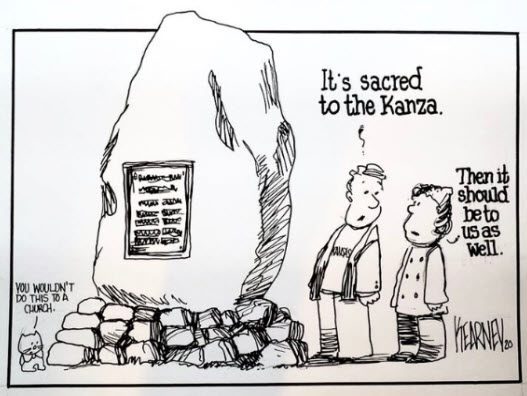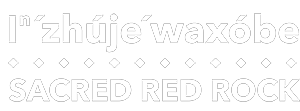Background
Home » Background of In‘zhúje‘waxóbe
Sacred Red Rock Project
Background of Iⁿ‘zhúje‘waxóbe
Iⁿ‘zhúje‘waxóbe / the Sacred Red Rock is a 28-ton red Siouxan quartzite boulder currently located in Robinson Park in Lawrence, Kansas. It was moved there from the confluence of the Shunganunga Creek and Kansas River in 1929 to become a monument to the early founders of the City of Lawrence. Kaw Nation has a centuries’ long relationship with the Iⁿ‘zhúje‘waxóbe and value it as a sacred item of prayer.
Read more about the significance of Iⁿ‘zhúje‘waxóbe in Curriculum.

Thanks to Editorial Cartoonist Greg Kearney
Formerly known as the Kanza (or Kansa) people, the Kaws are a federally recognized Indian tribe officially known as the Kaw Nation. Presently, there are 3,723 enrolled members who, under a legal agreement with the United States Department of Interior, conduct tribal business from their tribal headquarters at Kaw City in northern Oklahoma.
Starting in the spring of 2009, the Constitution Committee set out the task of revising the Constitution. Over the next two years, the committee held nearly a dozen public meetings for tribal citizens to solicit comments, sent out two surveys, and drafted a new constitution. A signed petition was presented to the Chairman at the April 2011 General Council meeting. This petition was certified by the Kaw Nation District Court, and a vote was set for Aug. 20, 2011, for the Kaw people to vote for or against ratification. The Kaw people voted 58 percent to 42 percent to accept the new Constitution as the organic law of the land.
Shortly thereafter, the Kaw Nation Tribal Council, formerly known as the Executive Council, began diligently working to implement the new Constitution. The 2011 Constitution calls for several actions to be voted on by the General Council, and these are currently being prepared for future General Council meetings.”
Read more about the Cultural History of the Kaw / Kanza People
Íⁿ’zhúje’waxóbe is also known as a red Sioux quartzite glacial erratic, native to eastern South Dakota and southwestern Minnesota. Geologists have said that the Shunganunga boulder was carried to Kansas from the area of the Dakotas on a glacier hundreds of thousands of years ago. The boulder came to rest on the banks of the Shunganunga Creek near Tecumseh, where the creek joins with the Kansas River.
In preparation for the rematriation of Iⁿ‘zhúje‘waxóbe to Allegawaho Memorial Heritage Park, our team consulted with University of Kansas geology professors Andreas Möller and Georgios Tsoflias regarding the current stability of the Rock and the base within which it sits. Möller, an expert in Siouxan quartzite boulders, was concerned about some surface features in the boulder so Tsoflias agreed to conduct a ground-penetrating radar (GPR) examination of Iⁿ‘zhúje‘waxóbe to determine its internal structure and integrity. The GPR assessment provided assurance that the Rock’s internal structure is sound and that the proposed move, if conducted with all due care, should not harm the Rock. Additionally, the GPR assessment was able to provide some limited insights regarding the structure of the Rock’s base and how the Founders’ Memorial Plaque is affixed. Joshua Meisel, geography and geographic information systems instructor at Haskell Indian Nations University, has completed a three-dimensional model of the Rock’s current location utilizing drone imagery with the assistance of tribal college students.
Read about the current location of Iⁿ’zhúje’waxóbe in Robinson Park.
Iⁿ‘zhúje‘waxóbe / the Sacred Red Rock (sometimes referred to as the Shunganunga boulder) is a 28-ton red Siouxan quartzite boulder currently located in Robinson Park in Lawrence, Kansas. It was moved there from the confluence of the Shunganunga Creek and Kansas River in 1929 to become a monument to the early founders of the City of Lawrence. Robinson Park is named after the state’s first governor and a former superintendent of Haskell Institute (at the time, it was a federal boarding school for Indigenous youth). In 1929, a large pink quartzite rock was erected in the park as a monument to the town’s “pioneers” and to celebrate the 75th anniversary of Lawrence’s founding.
Read more about the location and history of Iⁿ’zhúje’waxóbe in the Curriculum.
Project History
In 2015, while organizing the Kansas People’s History poster project, Lawrence, Kansas-based artist Dave Loewenstein contacted a member of the Kaw Nation Cultural Committee, Pauline Eads Sharp, to learn about the story of the large quartzite rock in Robinson Park, known to the Kaw as Iⁿ‘zhúje‘waxóbe, to see if it would make a good subject for a poster. This began their relationship, and they worked together to research and recall the stories of Iⁿ‘zhúje‘waxóbe to share with the Kaw People, and if possible, redress its misuse by the City of Lawrence. They soon discovered that others among Kaw Nation and the Lawrence community had been working to document the sacred rock’s history and significance for several decades. Bringing together this research, they discovered the original location of the Rock along the Kansas River, the Kaw Prayer Chart that includes Iⁿ‘zhúje‘waxóbe within it’s cycle, photos and accounts of the Rock’s relocation to Robinson Park in 1929.
Their research project gained momentum when they won support from Interchange, a new Mid-America Arts Alliance fellowship program (funded by the Mellon Foundation) in 2019. Preparing the application for Interchange titled, Between the Rock and a Hard Place, was the impetus for Pauline and Dave to gather a team of Lawrence residents and Kaw Nation citizens to begin the work of organizing historical materials and holding community engagement through large meetings prior to the Covid pandemic, and through virtual meetings thereafter. Through these dialogues it became clear that the Kaw Nation wanted to reengage with Iⁿ‘zhúje‘waxóbe. This led to the tribe’s formal request to the City of Lawrence for the return of Iⁿ‘zhúje‘waxóbe and plans for its relocation to Allegawaho Memorial Heritage Park, some 90 miles away, in Council Grove, Kansas. Allegawaho Park is a portion of the final reservation lands held by the Kaw Nation in Kansas before their 1873 relocation to Indian Territory (Oklahoma). The tribe’s motivation for relocating Iⁿ‘zhúje‘waxóbe to this park was a desire to have the Rock on lands owned by the tribe since 2002, alongside other tribal monuments, while keeping Iⁿ‘zhúje‘waxóbe in Kansas. In March 2021, this culminated in the City of Lawrence and Douglas County formally apologizing to the Kaw Nation for defacing and appropriating Iⁿ‘zhúje‘waxóbe and agreeing to its unconditional return to the Kaw people.
In early 2020, Pauline Eads Sharp and Dave Lowenstein, both now members of the Iⁿ‘zhúje‘waxóbe / Sacred Red Rock Project Leadership Team, began presenting to the local community and began conversations with the City of Lawrence and Douglas County about the importance of Iⁿ‘zhúje‘waxóbe to the Kaw people. In July of 2020, with the help of City staff and approval of both the City and County (watch the County Commission meeting about the project here), colorful new banners were installed at Robinson Park calling attention the Park’s name, history and meaning. Later, they would present to the Kaw Nation General Council, which would result in making a formal request for the return of Iⁿ‘zhúje‘waxóbe and a joint resolution joint the City and County for the return of Iⁿ‘zhúje‘waxóbe to the Kaw Nation.
The Iⁿ‘zhúje‘waxóbe / Sacred Red Rock Project is the next phase of the Between the Rock and a Hard Place Project and will support the rematriation of Iⁿ‘zhúje‘waxóbe, infrastructure and interpretation at Allegawaho Park, and programming in Lawrence and Council Grove that engages the community in this multifaceted story and envisions new possibilities for the place now known as Robinson Park. The Iⁿ‘zhúje‘waxóbe / Sacred Red Rock Project is being supported by a $5 million dollar Mellon Foundation Monuments Project grant to the University of Kansas. Funds will be used primarily for the relocation of Iⁿ‘zhúje‘waxóbe, including infrastructure at Allegawaho Memorial Heritage Park to support its display, security, and interpretation. This land has been owned by the tribe since 2002, is a portion of the final reservation lands of the Kaw Nation in Kansas before their 1873 relocation to Indian Territory (Oklahoma). Additional funds will be used for the creation of a documentary, a book, and to engage communities in both Council Grove and Lawrence, specifically about developing creative approaches to the use and interpretation of Robinson Park after Iⁿ‘zhúje‘waxóbe is moved.

